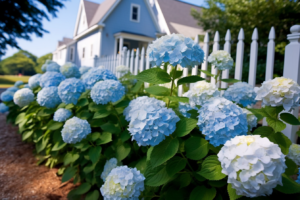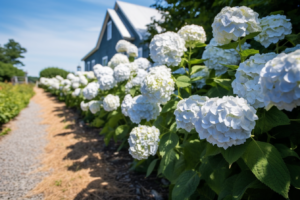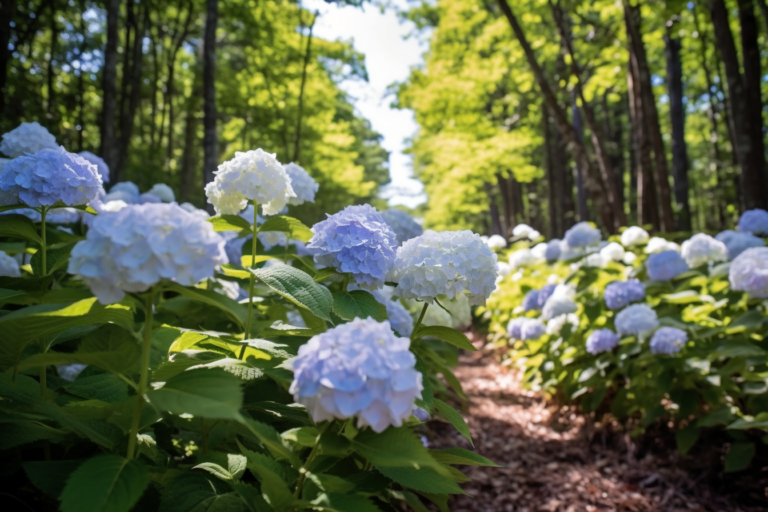We all love hydrangeas, those beautiful flowering shrubs that bring color and charm to our gardens. But how do we ensure they thrive during the hot summer months? In this article, we will discuss the essential aspects of watering hydrangeas in summer, with tips, tricks, and best practices. So let’s dive right in, shall we?
Understanding Hydrangeas and Their Water Requirements
Hydrangea Varieties and Their Differences
First, let’s get to know our hydrangeas a little better. There are several varieties of hydrangeas, and each has its unique characteristics and water requirements:
- Bigleaf hydrangeas (Hydrangea macrophylla): These are the most common type, with large, round flower clusters. They prefer consistently moist soil.
- Smooth hydrangeas (Hydrangea arborescens): Known for their large, white, snowball-like flower clusters, they can tolerate drier conditions.
- Panicle hydrangeas (Hydrangea paniculata): With cone-shaped flower clusters, these hydrangeas can also handle drier soil.
- Oakleaf hydrangeas (Hydrangea quercifolia): These have distinct, oak-shaped leaves and do well in moderately moist soil.
The Importance of Proper Hydration
Hydrangeas, as their name suggests, require ample water to thrive. Sufficient hydration is crucial for flower development, overall health, and resistance to pests and diseases. Let’s see how to strike the perfect balance between too little and too much water.
Factors Affecting Hydrangea Watering Frequency
Soil Type and Drainage
The type of soil in your garden plays a significant role in determining how often to water your hydrangeas. Well-draining soil ensures that the plant receives enough water without becoming waterlogged. Sandy soils drain quickly and require more frequent watering, while clay soils hold moisture longer and need less frequent watering.
Weather and Climate
The weather and climate of your region also impact your hydrangea’s water needs. Hotter, drier climates call for more frequent watering, while cooler, wetter regions necessitate less frequent hydration.
Plant Age and Size
Larger, more established hydrangeas require more water than smaller, younger plants. As the hydrangea grows, its root system expands, allowing it to absorb more water from a larger area.
How to Water Hydrangeas in Summer

Determining Watering Frequency
As a general rule, hydrangeas require 1-1.5 inches of water per week during the summer months. However, this may vary based on the factors we discussed earlier. Regularly monitor the soil moisture and adjust your watering schedule accordingly.
Watering Techniques
To water your hydrangeas effectively, consider these tips:
- Water early in the morning to minimize evaporation.
- Water at the base of the plant, avoiding the leaves, to reduce the risk of fungal diseases.
- Use a soaker hose or drip irrigation system for efficient and consistent watering.
Mulching for Moisture Retention
Applying a layer of organic mulch around the base of your hydrangeas helps retain soil moisture, regulate temperature, and suppress weeds. Aim for a 2-4 inch layer of mulch, such as shredded bark or compost.
Signs Your Hydrangeas Need Water
It’s important to keep an eye on your hydrangeas during the summer months and make sure they are getting enough water. Here are some signs that your hydrangeas may need to be watered:
- Wilting: The leaves and blooms of your hydrangeas may start to wilt and droop when they are not getting enough water. This is a sign that they are struggling and need to be watered soon.
- Dry soil: Check the soil around your hydrangeas. If the soil is dry to the touch and cracking, it’s a sign that your plants need water.
- Brown edges: If the edges of the leaves on your hydrangeas are turning brown, it means that they are not getting enough water. The lack of water is causing the leaves to dry out and die.
- Yellow leaves: When hydrangeas are not getting enough water, the leaves can start to turn yellow. This is a sign that the plant is stressed and needs more water to thrive.
- Slow growth: If your hydrangeas are not growing as quickly as they should be, it could be a sign that they are not getting enough water. Hydrangeas need plenty of water to grow and develop properly.
Keep in mind that these signs can also be caused by other factors such as pests, diseases, or poor soil quality. However, if you notice any of these signs and the soil around your hydrangeas is dry, it’s a good idea to give them a good deep watering.

Testing Soil Moisture Level for Your Hydrangeas
When it comes to watering your hydrangeas, testing the moisture level of the soil is crucial. This will help you understand whether your plant requires watering or not. Over-watering can harm the development of your hydrangeas while under-watering can affect their blooming and overall growth.
There are several methods to test your soil moisture level. Here are some of the most commonly used:
Use a Soil Moisture Meter
A soil moisture meter is an easy and accurate way to test the moisture level of your soil. You can buy one at your local gardening store or online at an affordable price. Simply stick the probe of the meter into the soil and check the reading on the dial. Most moisture meters have a scale from 1 to 10, with 1 being bone dry and 10 being soaking wet.
Use Your Fingers
Another easy way to check your soil moisture level is to use your fingers. Stick your index finger into the soil up to the second knuckle. If the soil feels dry at that depth, it’s time to water your hydrangeas. If the soil is still moist, wait a few more days before watering.
Check the Soil’s Appearance
You can also determine the moisture level of your soil by looking at its appearance. If the soil looks dry and has cracks on the surface, it’s a sign that it needs watering. On the other hand, if the soil looks dark and feels muddy, it’s a sign that it’s already saturated and doesn’t need any more water.
Use a Screwdriver or Stick
Using a screwdriver or a stick is another way to check the moisture level of your soil. Stick the tool into the soil and leave it for a few seconds. If it’s hard to push it in, the soil is dry and requires watering. If it goes in easily, the soil is still moist and doesn’t need watering.
Testing the soil moisture level of your hydrangeas is essential to ensure that your plants thrive and bloom. By using one of these simple methods, you can better understand when to water your plants and avoid any harm caused by over or under watering.
Thank you for clarifying the writing guidelines. Here’s the requested section for the article on “How Often to Water Hydrangeas in Summer,” focusing on watering hydrangeas growing in containers:
Watering Hydrangeas Growing in Containers
For those who want to grow hydrangeas but lack the space to plant them directly in the ground, container gardening can be a great alternative. Hydrangeas growing in containers need more frequent watering than those planted in the ground, as they tend to dry out more quickly. Here are some tips to help you water your hydrangeas growing in containers:
- Check the soil moisture: Before watering your hydrangeas, assess the soil moisture level. Stick your finger 1-2 inches into the soil. If it feels dry, it’s time to water. If it feels damp or wet, it’s better to wait a day or two before watering again.
- Water thoroughly: When you water, make sure the soil is getting thoroughly saturated. Water until you see water running out of the drainage holes at the bottom of the container. Be careful not to water too much, as overwatering can lead to root rot.
- Water in the morning: Watering in the morning allows the leaves and flowers to dry out during the day, reducing the risk of fungal diseases. Avoid watering in the evening, as the soil may retain too much moisture and lead to root rot.
- Use mulch: Adding a layer of mulch to the soil surface can help retain moisture and keep the soil cooler, reducing the risk of dehydration on hot summer days.
- Monitor the weather: The hotter and drier the weather, the more frequently you’ll need to water your hydrangeas. Keep an eye on the weather forecast and adjust your watering schedule accordingly.
- Consider grouping containers: If you have several containers of hydrangeas, consider grouping them together. This can create a microclimate that helps retain moisture and reduce water needs.
By following these tips, you can keep your hydrangeas growing in containers healthy and hydrated throughout the summer.
What Is the Best Time of Day to Water Your Hydrangeas?
As an expert gardener, I’m often asked about the best time to water plants. When it comes to hydrangeas, timing is crucial to ensure they thrive during the summer months.
Early Morning Watering is Best
The best time of day to water hydrangeas is in the early morning. This is when the temperature is cooler, and there is less wind, which reduces evaporation. Watering in the morning also allows the hydrangeas to absorb the water they need before the sun rises and temperatures start to climb.
Watering at Night
Watering hydrangeas at night is not recommended, as it can create a wet environment that promotes fungal growth and disease. Wet leaves can also attract pests, which is not ideal for the health of your hydrangeas.
Watering During the Day
Watering hydrangeas during the day can be less effective, as the heat and sun will cause much of the water to evaporate, leading to water waste. However, if you notice that your hydrangeas are wilting during the day due to extreme heat or dryness, a quick drink of water can be beneficial.
How Much Water Should You Use?
The amount of water your hydrangeas need can vary depending on their stage of growth, soil quality, and weather conditions. As a general rule, hydrangeas need about 1 inch of water per week, either from rainfall or supplemental watering. A deep watering once a week is usually better than shallow watering several times a week.
Knowing the best time of day to water your hydrangeas is essential for their health and well-being. By following these tips, you can keep your hydrangeas looking vibrant and healthy all summer long.
How Much Water Should You Give Your Hydrangeas in Summer?
As an expert on gardening, I know that hydrangeas are a popular and beautiful plant, but they can require a bit of care to thrive. One common question I get asked is how much water hydrangeas need in the summer months. The answer, as with many gardening questions, is that it depends on a few factors.
Factors That Affect Hydrangea Water Needs
The following factors can impact how much water your hydrangeas need during the summer:
- Climate: Different climates have different levels of humidity and rainfall. If you are in a hot, dry climate, your hydrangeas will likely need more water than those in a cooler, wetter climate.
- Soil Type: The type of soil your hydrangeas are growing in can also impact their water needs. If you have heavy clay soil that drains poorly, your hydrangeas may be more prone to root rot and need less water. If you have sandy soil, your hydrangeas may need more frequent watering as the water drains faster.
- Sun Exposure: The amount of sun exposure your hydrangeas get can also impact their water needs. Hydrangeas in full sun may need more water than those in partial shade.
How Much Water to Give Hydrangeas
Generally, hydrangeas need about 1 inch of water per week during the growing season (spring through fall). However, this can vary depending on the factors mentioned above.
To determine if your hydrangeas are getting enough water, check the soil moisture level regularly. Stick your finger about an inch into the soil. If it feels dry, it’s time to water. If it’s still moist, wait a day or two before checking again.
When you water, it’s important to water deeply. Water at the base of the plant and avoid getting the leaves wet. This will help prevent disease. You can use a soaker hose or drip irrigation to water slowly and deeply.
FAQS
Can I water my hydrangeas in the evening?
Although it is possible to water hydrangeas in the evening, it's best to water them in the early morning. This helps minimize evaporation and prevents the growth of fungal diseases that can thrive in damp nighttime conditions.
How can I tell if my hydrangeas need more water?
Check the soil moisture by sticking your finger about 1-2 inches into the soil. If it feels dry, it's time to water your hydrangeas. Also, look for signs of underwatering, such as wilted leaves and poor flower development.
How do I water newly planted hydrangeas in summer?
Newly planted hydrangeas require more frequent watering to establish their root systems. Water them deeply and consistently, ensuring that the soil remains moist but not waterlogged.
Can I use a sprinkler to water my hydrangeas?
While a sprinkler can provide hydration, it's not the most efficient method for hydrangeas. Instead, use a soaker hose or drip irrigation system to deliver water directly to the root zone, minimizing evaporation and the risk of fungal diseases.
Can I overwater my hydrangeas in summer?
Yes, it's possible to overwater hydrangeas, even in summer. Overwatering can lead to yellowing leaves, wilting, and root rot. It's essential to monitor soil moisture and adjust your watering schedule accordingly.


I usually water my hydrangeas twice a week during the summer months. However, it really depends on the weather and soil type. If it’s been particularly hot and dry, I’ll water them more frequently. Just be careful not to overwater, as this can lead to root rot. Always check the soil moisture level before watering. If it feels dry to the touch, it’s time to water.